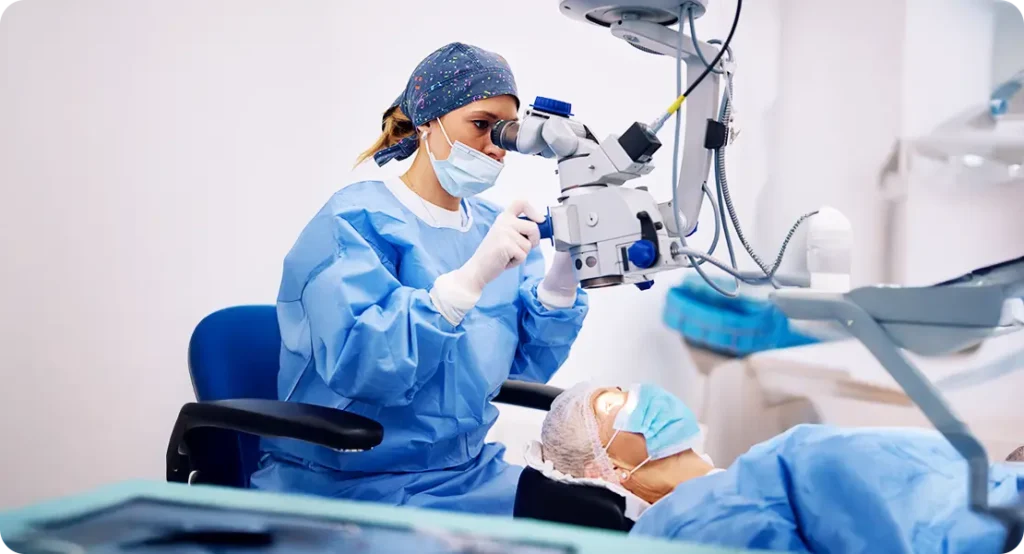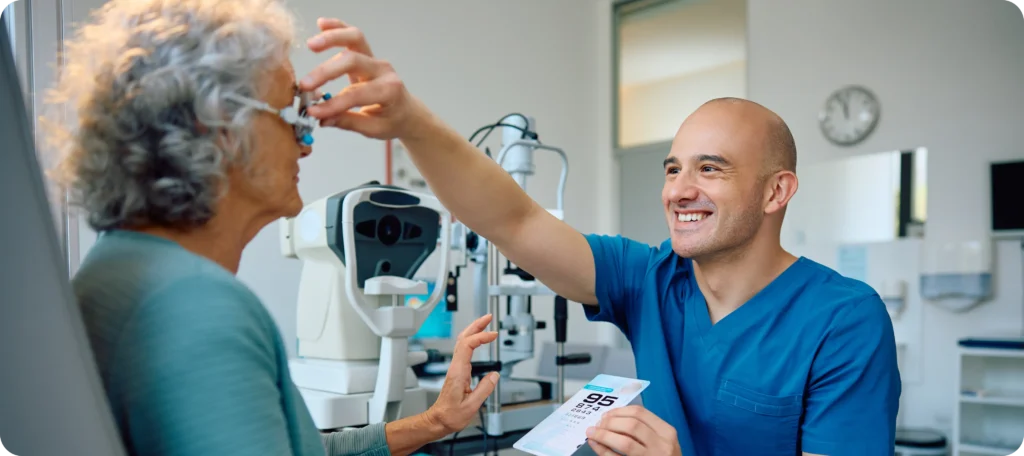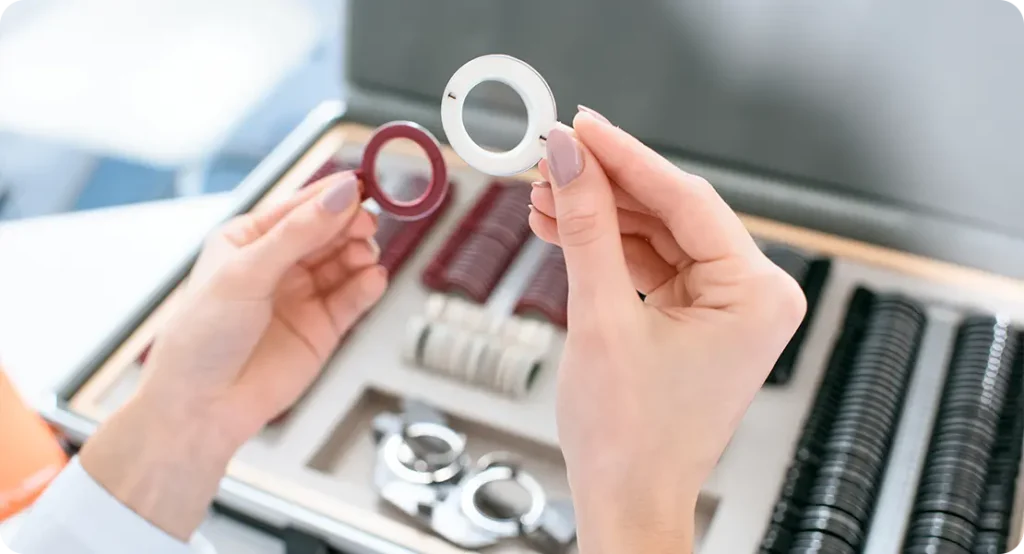If you’ve had cataract surgery and your vision has started to go blurry again, you might be wondering if something’s gone wrong. That’s where the term “secondary cataract” often comes into play. It’s not another cataract in the traditional sense, but it can be just as frustrating. Here are 20 of the most common questions patients ask about secondary cataracts — and honest, straightforward answers to help you make sense of it all.
1. What is a secondary cataract?
A secondary cataract isn’t actually a new cataract forming on the eye, although the name makes it sound like that. What’s really happening is that the back part of the lens capsule – which was left intact during your cataract surgery to support the new lens implant – becomes cloudy. This cloudiness is known as posterior capsule opacification (PCO), and it can cause similar symptoms to your original cataract.
So even though the cataract itself was successfully removed during surgery, this leftover membrane can thicken or wrinkle over time. That change scatters light and reduces clarity, which is why your vision might seem like it’s going backwards. It’s a very common occurrence and can happen months or even years after surgery.
The good news? It’s treatable. While it might feel like a step back, secondary cataracts are not a sign that your surgery failed. They’re simply a normal and often expected side effect of healing and time.
2. Why does a secondary cataract happen after surgery?
After your cataract is removed, the artificial lens is placed into the natural lens capsule – kind of like putting a coin in a small plastic bag. Over time, the cells on the back of that capsule can start to grow and become cloudy. This is the body’s way of reacting to surgery – it thinks it’s helping by healing, but unfortunately, that healing can interfere with vision.
This clouding doesn’t affect everyone in the same way. Some people might notice symptoms very quickly, while others may not have any issues for years – or ever. It’s a bit unpredictable, but factors like age, inflammation after surgery, or certain eye conditions can increase the likelihood of developing a secondary cataract.

It’s important to know that this isn’t something you can prevent with drops or lifestyle changes. It’s just one of those things that can happen – but it’s relatively easy to fix, which we’ll get into shortly.
3. How do I know if I have a secondary cataract?
The symptoms of a secondary cataract are a lot like those you had before your first cataract surgery. You might notice your vision becoming blurry or cloudy again, colours may seem duller, and it could be harder to see clearly in bright light. Some people even report glare or halos around lights, especially when driving at night.
It can be quite frustrating, especially if your vision was sharp right after surgery. If you’re finding that reading is more difficult, or your glasses no longer seem to help, that’s another clue that something’s not right. The changes usually come on gradually, so it might be a while before you realise what’s happening.
If any of this sounds familiar, it’s a good idea to book an eye check-up. Your optometrist or ophthalmologist can easily see if the back of the capsule is cloudy during an eye examination. They’ll use a special microscope to look inside your eye and confirm whether a secondary cataract is the culprit.
4. Can a secondary cataract affect both eyes?
Yes, it can – but only if you’ve had cataract surgery in both eyes. A secondary cataract forms on the lens capsule left behind during cataract surgery, so it’s not something that develops in a completely untouched eye. If you’ve only had surgery in one eye, then only that eye is at risk.
If both eyes have been operated on, each eye can independently develop a secondary cataract. It’s not contagious or connected in the way infections are, but the same biological process can occur in each eye over time. It’s also worth noting that one eye might develop it before the other, or the symptoms might be worse on one side.
The good part? If it happens in both eyes, the treatment is generally straightforward in each case. It doesn’t mean anything is wrong with the artificial lenses or that anything has gone seriously wrong. It’s simply a normal, treatable change that sometimes follows surgery.
5. Is a secondary cataract dangerous?
A secondary cataract is not dangerous in the sense of causing permanent damage or leading to blindness. However, it can significantly reduce your quality of life if it’s left untreated. Things like reading, driving, or watching television can become increasingly difficult, which can impact your independence and day-to-day activities.
That said, a secondary cataract doesn’t harm the eye itself. It doesn’t cause pain, inflammation, or raise the pressure inside the eye. It’s more of a nuisance than a threat. The main issue is how much the cloudiness interferes with your vision and whether you feel you need something done about it.

If you find the symptoms manageable, you don’t have to rush into treatment. But if your vision is clearly deteriorating and it’s starting to affect your life, then the best course of action is to consider having it corrected – which is typically done with a quick, painless laser procedure.
6. How is a secondary cataract treated?
Treatment for a secondary cataract is quick and non-invasive. It’s usually done with a procedure called YAG laser capsulotomy. The laser creates a small opening in the cloudy capsule, which lets light pass through clearly again, restoring your vision. It doesn’t involve any incisions or injections – just a short laser session, often lasting less than five minutes.
You’ll typically sit at a machine similar to the one used during your regular eye checks. The laser itself is painless – most people say they don’t feel a thing. You might notice some floaters or light flashes immediately after, but these usually settle down within a few days. You can usually go home shortly after the procedure, and many people notice clearer vision within 24 hours.
It’s usually a one-time fix, and the cloudiness doesn’t tend to come back after laser treatment. So once it’s done, that’s often the end of the problem. It’s a very common and safe procedure with a high success rate – most people are surprised by how simple it all is.
7. Is YAG laser capsulotomy safe?
Yes, YAG laser capsulotomy is generally considered a very safe procedure. It’s been used for decades and is one of the most common laser treatments performed on the eye. Like any medical procedure, there are some risks, but serious complications are rare. For the vast majority of patients, the benefits far outweigh the small chance of side effects.
Some people might experience floaters for a while afterwards, and a very small number may notice a temporary spike in eye pressure. In even rarer cases, there can be issues like swelling or retinal detachment – but again, these are uncommon. Your ophthalmologist will assess your eyes beforehand to make sure you’re a good candidate and monitor you after the procedure to catch anything early.
If you’ve got other eye conditions like glaucoma or diabetic retinopathy, your doctor might take extra precautions. But overall, the procedure is quick, low-risk, and often restores your vision to how it was just after cataract surgery.
8. Will the secondary cataract come back after laser treatment?
The nice thing about YAG laser capsulotomy is that once it’s done, the problem usually doesn’t return. The cloudy capsule is opened permanently, so there’s no surface left for those unwanted cells to grow back over. In most cases, this means your vision will stay clear from then on.
That said, some people do report floaters or other minor visual disturbances after the procedure. These aren’t signs of the secondary cataract coming back, but rather a result of the laser opening – bits of capsule tissue can occasionally float around before settling down. Your eye adjusts, and over time, these floaters usually become less noticeable.
If new visual problems pop up down the line, they’re more likely related to other eye conditions, not a regrowth of the secondary cataract. But if you’re ever unsure, it’s always worth getting checked again for peace of mind.
9. Is there any recovery time after YAG laser treatment?
Most people are back to normal the same day. There’s no need for bandages or eye drops in most cases, and you can usually drive, read, and do your usual activities within a few hours. Your vision might be a bit blurry or flickery immediately after the procedure, but that tends to clear quite quickly.

Some people find that their eye feels slightly gritty or dry for a day or two, but it’s not painful. You might notice floaters for a while, especially in the first few days. These are harmless and tend to fade as your eye adjusts. Your doctor will likely book a follow-up appointment to check everything’s settled nicely.
Unless your ophthalmologist tells you otherwise, there’s no need to take time off work or make major lifestyle changes. It’s one of the easiest recoveries in eye care – a bit of rest and avoiding rubbing your eyes is usually all that’s needed.
10. Do I need to prepare before YAG laser capsulotomy?
There’s very little you need to do beforehand. You’ll usually be asked to come in without any eye makeup or creams near your eyes. Your doctor may use drops to dilate your pupils, which helps them get a clearer view of the capsule. That might make your vision a bit blurry and sensitive to light for a few hours after the procedure.
You won’t need to fast or stop any regular medications unless told otherwise. Most clinics suggest bringing someone with you to drive you home, as the dilation can affect your vision temporarily. Other than that, there’s no major prep involved – it’s a very straightforward appointment.
Your eye will be numbed with drops before the laser starts, so there’s no discomfort. The whole thing is done while you’re awake, and most people find it surprisingly easy – far less daunting than they expected.
11. How long does YAG laser capsulotomy take?
The laser part of the procedure only takes a few minutes – often less than five. You’ll spend more time in the clinic getting checked before and after the treatment than having the laser itself. It’s a fast, painless process that doesn’t require any cuts or injections.
Once you’re seated at the laser machine, the ophthalmologist will focus a special lens on your eye to guide the laser beam. They’ll then use short, precise pulses to make the small opening in the capsule. Most people are surprised by how quick and simple it all feels.
You’ll usually be observed for a short time afterwards, especially if you’re prone to eye pressure changes. After that, you’re free to go home and get on with your day. It’s one of the quickest and most effective procedures in ophthalmology.
12. Can I drive after the laser treatment?
It depends on how your vision responds to the dilating drops and the laser. If your pupils were dilated before the procedure, your vision might be too blurry or sensitive to drive safely for a few hours. In that case, it’s best to have someone drive you home just to be safe.
Some people find their vision returns to normal quite quickly, but others may notice light glare or floaters that could make driving uncomfortable. For most, things settle by the next day, and you’ll be able to drive as usual. But it’s a good idea to take the rest of the day off from tasks requiring sharp focus.
Always check with your ophthalmologist before getting behind the wheel, especially if you feel unsure. Better to err on the side of caution than to risk your safety or someone else’s.
13. Is the laser treatment covered by the NHS?
Yes, in most cases, YAG laser capsulotomy is available on the NHS. If your secondary cataract is affecting your vision to the point where it interferes with daily life – such as driving or reading – your GP or optician can refer you to an NHS eye clinic for assessment and treatment.
Waiting times can vary depending on your location and the current demand for services. If you’re finding the delay difficult, private treatment is also an option, and many clinics offer reasonably priced packages for the procedure. But for many patients, NHS care provides the treatment they need without out-of-pocket costs.
It’s worth speaking with your optician first, as they can advise whether your symptoms are likely to qualify for NHS referral. They’ll also be able to tell you what to expect from the process and how long it might take.
14. Can glasses fix a secondary cataract?
Unfortunately, no – glasses can’t correct the problem caused by a secondary cataract. The cloudiness is on the inside of the eye, behind the artificial lens, and glasses simply can’t reach or compensate for it. If your vision has suddenly worsened and your glasses aren’t helping, that’s often a clue that something deeper is going on.

That being said, people sometimes try new prescriptions before discovering they’ve developed a secondary cataract. It’s easy to assume your glasses just need an update, but if nothing seems to sharpen your vision, it’s best to get an eye exam. Your optician or ophthalmologist can look inside the eye and tell you straight away if the capsule is cloudy.
If it turns out to be a secondary cataract, the only real fix is the laser procedure. It clears the capsule and allows your artificial lens to work properly again – glasses can then be used as normal for near or distance tasks, depending on your lens type.
15. Can young people get secondary cataracts?
Yes, secondary cataracts can affect people of all ages who’ve had cataract surgery, including younger individuals. While cataracts are more common in older adults, younger patients may develop them due to conditions like trauma, diabetes, or certain medications. Once they’ve had surgery, the risk of a secondary cataract is similar regardless of age.
In fact, younger people may be more likely to experience posterior capsule opacification (PCO) because their lens cells tend to be more active. Their bodies are usually better at healing and regenerating tissue, which ironically increases the chance of the capsule becoming cloudy again after surgery.
That said, the treatment and outcome are the same regardless of age. YAG laser capsulotomy works just as effectively in younger patients, and most people – young or old – go on to enjoy clear vision again without any long-term issues.
16. Can a secondary cataract cause permanent vision loss?
A secondary cataract on its own does not cause permanent vision loss. The cloudy capsule might make your vision blurry or foggy, but it doesn’t damage the retina or optic nerve. Once the clouded membrane is removed with the laser, your sight typically returns to how it was after the original surgery.
However, if the condition is left untreated for a long time, it can start to interfere with things like depth perception or light sensitivity. That might increase your risk of accidents or falls, especially in older adults. So while it won’t destroy your vision, it can certainly affect your safety and quality of life if ignored.
The key is recognising the symptoms and getting checked promptly. As long as it’s dealt with, most people recover their vision quickly and permanently. It’s reassuring to know that it’s one of the more manageable issues when it comes to eye health.
17. Are there any alternatives to laser treatment?
Currently, YAG laser capsulotomy is the gold standard for treating secondary cataracts. There aren’t really any non-laser alternatives that are as quick, effective, or safe. Eye drops, supplements, or glasses won’t make the cloudiness go away – it needs a physical opening to be made in the capsule for light to pass through again.
Some people worry about lasers and wonder if there’s a surgical option instead. While technically it’s possible to remove the cloudy capsule surgically, this approach is far more invasive, carries greater risks, and is rarely done. The laser is preferred because it’s so precise, fast, and low-risk.
So if you’re holding out for another option, it’s worth knowing that YAG laser is already the simplest and safest route. It might sound high-tech or intimidating, but it’s incredibly routine – often performed in the same clinic room as your eye exam.
18. Will I need new glasses after the laser treatment?
That depends on how well your artificial lens is functioning and whether your prescription has changed over time. Many people find that their vision improves so much after YAG laser capsulotomy that their current glasses suddenly work better. Others may still benefit from a slight prescription tweak afterwards.

It’s a good idea to wait a week or two after the procedure before updating your glasses, just to let your vision fully stabilise. Some people feel the difference straight away, while others take a bit longer to notice improvements. Floaters might linger for a short while, but they usually settle down without impacting clarity.
Once your vision has stabilised, you can have an eye test to see if any new correction is needed. In many cases, especially with multifocal lenses, patients feel happy enough not to need any change at all. It really depends on your individual eyes and visual needs.
19. How common are secondary cataracts?
Secondary cataracts are very common – in fact, they’re the most frequent complication following cataract surgery. Estimates suggest that around 20% to 30% of people will develop one within a few years of surgery, although it can happen sooner or later depending on the person.
The likelihood is higher if you’re younger, have certain medical conditions like diabetes, or experienced inflammation after your surgery. That said, even those with smooth recoveries and no risk factors can still develop one. It’s just a natural result of how the eye heals and reacts over time.
It’s important to remember this doesn’t mean your surgery went wrong. It’s a bit like needing to polish a window that’s gathered dust – the lens itself is still perfectly fine, but the view through it has become cloudy. Fortunately, it’s one of the easiest things to fix.
20. Should I be worried about getting a secondary cataract?
No need to worry – just be aware. Secondary cataracts are common and treatable, and they don’t pose a serious threat to your vision or eye health. If your vision starts to blur again after cataract surgery, it’s something to have checked – but not something to panic over.
What matters most is recognising the symptoms early and getting a professional opinion. Don’t wait months hoping things will clear on their own. The sooner you know what’s going on, the sooner you can get back to seeing clearly again. And remember, the treatment is quick, painless, and has a high success rate.
So rather than stressing about the possibility, just know what signs to look out for and trust that effective help is available. With proper care, secondary cataracts are just a small bump in the road to lasting clear vision.
Final Thoughts
Dealing with blurred vision after cataract surgery can be confusing, but understanding secondary cataracts – and knowing that they’re treatable – makes a big difference. While they might feel like a setback, they’re actually a very common and manageable part of the cataract journey. With a simple laser procedure, most people are back to enjoying clear, sharp vision in no time.
If you’re noticing changes in your sight and suspect a secondary cataract might be the cause, it’s always best to get it checked sooner rather than later. The earlier it’s identified, the sooner you can get back to doing the things you enjoy without visual interference.
If you’d like to speak with someone about your symptoms or arrange an assessment, feel free to contact us at the London Cataract Centre. Our expert cataract surgeons are here to help you understand your options and guide you towards the best solution for your vision.

